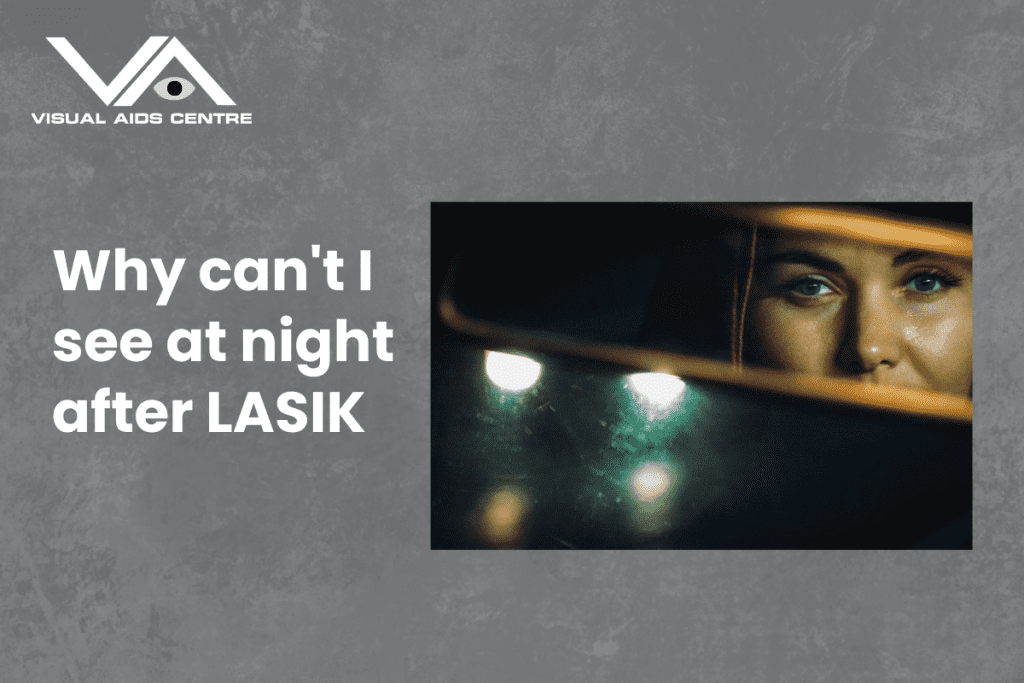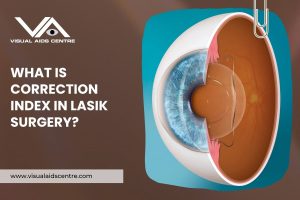Table of Contents
ToggleNight vision disturbances after LASIK are a common, though temporary, side effect for many patients.
These issues often include glare, halos, and difficulty seeing in low-light conditions, and they occur because of how the cornea heals and reacts after the procedure.
Understanding why these disturbances occur can help you manage expectations and take steps to improve your vision as your eyes recover. This blog will break down everything you need to know about post-LASIK night vision problems, offering insights into why they happen and when they’re likely to be resolved.

What Causes Night Vision Problems After LASIK?
1. Changes to the Corneal Surface
The LASIK procedure involves reshaping the cornea to correct refractive errors such as nearsightedness, farsightedness, or astigmatism. However, during the healing process, the corneal surface may become irregular or uneven.
- Effect on Vision: When light enters your eye, these irregularities scatter the light instead of directing it to a single point on the retina. This scattering creates glare, starbursts, or halos around lights, which are especially evident in darkness.
2. Pupil Size in Low Light
Your pupil naturally dilates in dark environments to allow more light in. However, if your pupil expands beyond the area of the cornea that was treated during LASIK, it may encounter untreated portions.
- Effect on Vision: This discrepancy can create distortions, as light entering from the untreated parts of the cornea doesn’t focus correctly on the retina. This is one reason why larger pupils are more commonly associated with night vision issues post-surgery.
3. Temporary Dry Eye Syndrome
LASIK can disrupt the tiny nerves in your cornea responsible for stimulating tear production, often leading to post-surgical dry eye.
- Effect on Vision: When your eyes are dry, the quality of the tear film—which is crucial for clear vision—can deteriorate. This poor tear film can accentuate glare and blurriness in dark environments.
4. Healing and Tissue Regeneration
The healing process plays a significant role in determining your visual clarity after LASIK. It may take several weeks or months for your eyes to fully adjust and settle post-operation.
- Effect on Vision: During this period, fluctuating vision or sensitivities in low light are common as your corneal tissue stabilises.
5. Pre-Existing Vision Conditions
If you had higher degrees of refractive errors before LASIK, you might be slightly more susceptible to night vision disturbances. Additionally, underlying conditions like large pupils or thin corneas can increase these effects.
- Effect on Vision: These factors can make it harder to achieve perfect visual outcomes immediately after surgery, especially under dim lighting.
How Long Do These Night Vision Issues Last?
The good news is that most night vision problems after LASIK are temporary and improve as your eyes heal.
- Short-Term Recovery: Many patients notice significant improvements within the first few weeks or months after surgery, as the cornea stabilises and the nerves regain some functionality.
- Long-Term Recovery: For a small percentage of patients, night vision disturbances can last six months or longer. However, ongoing issues this far out should be discussed with your ophthalmologist.
The key is patience, as your eyes need time to adjust post-surgery. By consistently attending follow-up appointments, your surgeon can monitor healing and address any lingering concerns.
What Can You Do to Improve Night Vision Post-LASIK?
1. Proactively Address Dry Eye
Managing dry eye can significantly improve not only overall vision but also clarity at night.
- Use preservative-free lubricating eye drops at regular intervals.
- Consider prescribed treatments like punctal plugs or medicated eye drops for severe dry eyes.
2. Follow Post-Op Care Instructions
Adhering to your surgeon’s recommendations is critical for optimal results.
- Avoid rubbing your eyes, as this can disrupt the corneal flap created during LASIK.
- Use prescribed medications or eye drops to support healing and prevent inflammation.
3. Minimise Exposure to Bright Lights
Bright lights, especially while driving at night, can make glare or halos more pronounced.
- Wear polarised sunglasses during the day to reduce light sensitivity and protect your healing eyes.
- Use anti-glare coatings for your glasses or a visor while driving at night if needed.
4. Practice Patience
While it can be frustrating to experience these side effects, remember that they’re likely temporary. Track your symptoms and report any changes or concerns to your eye doctor promptly.
5. Discuss Vision Supplements
Some nutritionists recommend supplements like omega-3 fatty acids to reduce dry eye and improve tear quality. Always consult with your doctor before adding any supplements to your routine.
Could Pre-Surgical Factors Be to Blame?
Certain factors can increase the likelihood of experiencing night vision disturbances after LASIK. Assessing your suitability for LASIK carefully with your ophthalmologist ensures you’re fully informed.
- High Refractive Errors: Patients with very severe myopia or astigmatism might have more difficulty achieving perfection with surgery.
- Large Pupils: Naturally larger pupils increase the likelihood of post-op light distortions.
- Age: While LASIK is suitable for most adults, older patients may experience slower healing or complications like dry eye, which can affect night vision.
If you’re a potential LASIK candidate, discussing these concerns during your consultation is crucial.
Can Night Vision Problems Be Treated?
Yes, if symptoms persist beyond the typical healing period, there are solutions to aid long-term night vision issues:
Enhancement or Touch-Up Procedures
Some patients benefit from a LASIK enhancement procedure to refine their vision further. This is especially helpful if your initial surgery didn’t fully correct the underlying refractive error.
Specialised Eye Drops
For those with long-term dry eye, prescription medicated drops or autologous serum drops made from your blood plasma may help.
Contact Lenses
Custom-designed lenses, such as scleral or wavefront-guided lenses, can correct residual irregularities on the cornea and improve night vision.
Collaboration with Your Doctor
Advanced imaging and diagnostic tools can identify specific irregularities in the cornea that may need targeted treatment. Your doctor could also suggest therapies like corneal cross-linking (CXL) for stabilisation.
Don’t hesitate to reach out to your eye surgeon if night vision concerns persist. They’ll work closely with you to explore these or other treatment options based on your specific needs.
When Should You Consult Your Doctor?
While most night vision disturbances after LASIK are temporary, some symptoms warrant immediate attention, including:
- Sudden pain in the eyes
- Significant drop in visual acuity
- Persistent glare or halos with no signs of improvement
- Difficulty carrying out daily activities due to vision problems
Early intervention can prevent complications and help resolve lingering issues.
Wrapping Up
Night vision disturbance shortly after LASIK might be frustrating, but it’s generally a normal and temporary part of the recovery process. Understanding the causes—such as corneal healing, pupil size, or dry eyes—can help you manage these effects and set realistic expectations.
Most patients will find their night vision improves significantly in the weeks and months following surgery as their eyes fully heal. However, if night vision problems persist, there are targeted treatments that can provide relief.
If you’re considering LASIK and have concerns about how it might affect your night vision, consult a qualified ophthalmologist. Armed with the right knowledge, you can enjoy clearer vision in both daylight and dim light conditions.













